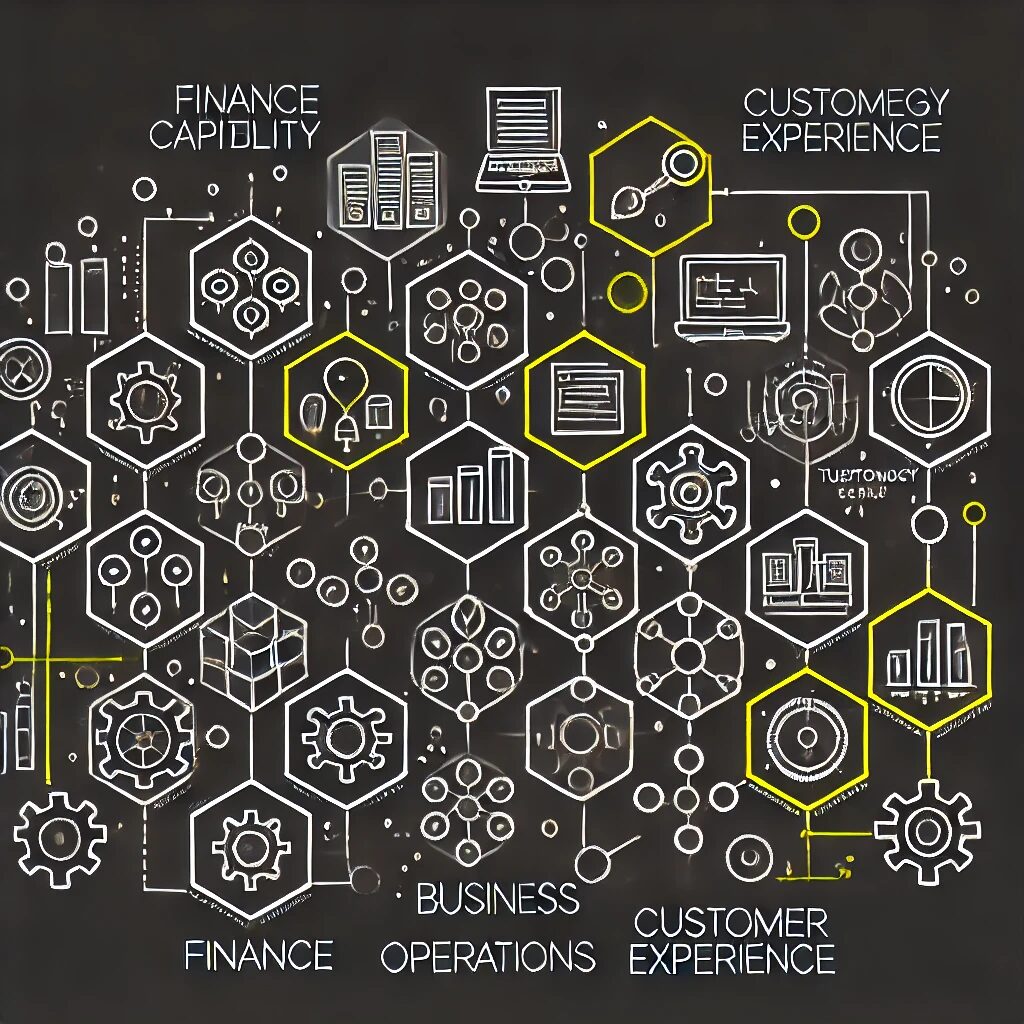
Optimizing Wealth Management Through Value Stream Architecture. From Client Value to Operational Excellence: The Strategic Power of Value Streams
In today’s competitive wealth management landscape, firms face mounting pressure to deliver exceptional client experiences while controlling costs, navigating complex regulations, and responding rapidly to market shifts. Traditional operating models often struggle with siloed functions, fragmented processes, and disconnected technology, undermining client satisfaction and operational efficiency.
Business Architecture Value Streams offer a transformative framework for wealth management firms seeking operational excellence. By mapping end-to-end value delivery from the client perspective—independent of organizational boundaries—value streams illuminate the cross-functional activities, information flows, and capabilities required to deliver meaningful outcomes. This powerful lens enables targeted optimization that enhances client experiences while streamlining operations across the wealth management value chain.
1: Understanding Value Streams in Business Architecture
Value Streams represent the end-to-end sequence of activities that deliver specific value to wealth management clients or stakeholders. Unlike process flows, they provide a strategic, outcome-focused view that transcends organizational boundaries.
- Value Stream Definition: A Value Stream captures the sequential stages through which value is created, delivered, and realized for wealth management clients, emphasizing outcomes rather than tasks or functions.
- Strategic Perspective: Value Streams connect directly to business strategy by illuminating how the firm actually delivers on its value proposition through operational activities and capabilities.
- Client-Centric Orientation: Unlike internal process maps, Value Streams begin and end with client triggers and outcomes, ensuring optimization efforts focus on enhancing actual client experiences.
- Cross-Functional Lens: Value Streams transcend departmental boundaries to reveal how value flows across the organization, highlighting collaboration requirements and interdependencies.
- Architectural Foundation: Value Streams provide the organizing framework for connecting business capabilities, processes, information, and technology into a coherent operational model.
2: The Anatomy of a Wealth Management Value Stream
Wealth management Value Streams follow a consistent structure that clarifies how value flows from initial client needs to final outcomes. This framework ensures comprehensive coverage of the end-to-end client experience.
- Value Stream Stages: Each Value Stream comprises 5-9 sequential stages that represent major value-adding activities from initial trigger to final value realization for the client.
- Stage Outcomes: Every Value Stream stage has clearly defined success criteria that articulate the incremental value created before progressing to the next stage.
- Capability Alignment: Value Stream stages connect directly to the business capabilities required to deliver each portion of the overall value proposition.
- Information Requirements: Value Streams identify the critical information needed and produced at each stage to enable effective decision-making and client service.
- Stakeholder Mapping: Each Value Stream stage identifies the key participants involved in value delivery, including clients, advisors, operations teams, and external partners.
3: Core Value Streams for Wealth Management
Wealth management firms typically organize around several foundational Value Streams that reflect their core business activities. These Value Streams form the backbone of operational optimization efforts.
- Client Acquisition: This Value Stream encompasses all activities from prospect identification through needs assessment, proposal development, and account opening that establish new client relationships.
- Financial Planning: The end-to-end journey of understanding client goals, analyzing current financial position, developing recommendations, and implementing personalized financial plans.
- Investment Management: Activities spanning from investment policy creation through asset allocation, portfolio construction, trading execution, and ongoing performance management.
- Relationship Management: The continuous cycle of client review meetings, service delivery, life event responses, and relationship deepening that maintains and expands client engagement.
- Wealth Transfer: Activities supporting intergenerational wealth transition, including estate planning, trust establishment, beneficiary management, and successor relationship development.
Did You Know:
- A 2024 Gartner study found that wealth management firms using Value Stream architecture achieve 34% faster client onboarding times and 28% higher client satisfaction scores compared to firms using traditional process improvement approaches.
4: Value Stream Mapping for Operational Diagnostics
Value Stream mapping provides powerful diagnostic insights that highlight operational inefficiencies and improvement opportunities across the wealth management organization.
- Value Leakage Identification: Value Stream analysis reveals where client value is diminished through delays, errors, redundant steps, or poor information flow between functional areas.
- Handoff Analysis: Mapping value flow across organizational boundaries exposes problematic handoffs where time, information, or accountability is frequently lost.
- Wait Time Exposure: Value Stream assessment quantifies where client value is delayed through approval bottlenecks, decision paralysis, or queue management issues.
- Effort Misalignment: Analysis reveals where disproportionate effort is expended on activities that deliver minimal client value, enabling resource reallocation to higher-impact activities.
- Experience Friction: Client journey mapping within Value Streams highlights pain points where operational complexity creates negative experiences that undermine relationships.
5: Connecting Value Streams to Business Capabilities
Value Streams and business capabilities form a powerful analytical matrix that revolutionizes operational optimization efforts in wealth management firms.
- Value-Capability Matrix: Mapping capabilities to Value Stream stages creates a comprehensive view of which organizational functions support specific client outcomes.
- Capability Utilization: The matrix reveals which capabilities are used across multiple Value Streams, highlighting strategic functions that warrant priority investment.
- Gap Identification: Value Stream-capability analysis exposes missing or underdeveloped capabilities that compromise value delivery to wealth management clients.
- Redundancy Exposure: The matrix highlights redundant capabilities performing similar functions across different Value Streams, revealing consolidation opportunities.
- Heat Mapping: Visualization techniques identify capability “hot spots” that represent either critical operational risks or strategic improvement opportunities across Value Streams.
6: Value Stream Optimization for Client Experience Enhancement
Value Streams provide a powerful framework for enhancing wealth management client experiences by aligning operational improvements directly with moments that matter in the client journey.
- Moment Mapping: Value Stream analysis identifies the critical interactions within each stage that disproportionately shape client perception and satisfaction.
- Experience Redesign: Value-based assessment enables experience enhancements that focus on outcome delivery rather than superficial service improvements.
- Channel Optimization: Value Stream analysis across delivery channels ensures consistent experience quality whether clients engage through digital self-service, advisor-led, or hybrid interactions.
- Expectation Management: Clear Value Stream stage outcomes enable better client communication about what will happen when, improving perceived service quality.
- Personalization Enablement: Value Stream assessment identifies critical decision points where client data can enable personalized experiences that strengthen relationships.
7: Process Optimization Through Value Stream Lens
Value Streams transform process improvement from isolated efficiency initiatives to strategic enhancements that directly improve client outcomes and advisor effectiveness.
- Process Prioritization: Value Stream mapping identifies which processes have the greatest impact on client outcomes, enabling focused improvement efforts where they matter most.
- End-to-End Perspective: The Value Stream context ensures process optimization addresses complete client journeys rather than creating isolated efficiencies that don’t improve overall outcomes.
- Cross-Functional Alignment: Value Stream frameworks enable process improvements that span departmental boundaries, eliminating the handoff issues that traditionally undermine client experiences.
- Elimination of Non-Value Activities: Value Stream analysis distinguishes between activities that contribute to client outcomes versus those that merely serve internal purposes and can be eliminated.
- Measurement Alignment: Process metrics derived from Value Stream objectives ensure improvements are judged by their contribution to client outcomes rather than internal efficiency alone.
8: Technology Portfolio Optimization
Value Streams provide the business context needed to transform technology from a collection of applications into a strategic enabler of wealth management outcomes.
- Application-to-Value Mapping: Associating applications with Value Stream stages reveals how technology directly supports client outcomes across the wealth management lifecycle.
- Investment Prioritization: Value Stream significance guides technology investment decisions, ensuring limited resources focus on applications that enable critical client outcomes.
- Integration Requirements: Value Stream information flows highlight where system integration is needed to enable seamless experiences and efficient operations across functional boundaries.
- Digital Enablement: Value Stream analysis identifies high-impact opportunities for new digital capabilities that can enhance client value delivery or advisor effectiveness.
- Legacy Modernization: Value Stream assessment helps prioritize which legacy systems should be addressed first based on their impact on strategic client outcomes.
9: Organizational Alignment Through Value Streams
Value Streams provide a powerful lens for optimizing organizational structures to enhance collaboration and accountability for client outcomes.
- Team Alignment: Value Stream mapping guides the formation of cross-functional teams organized around client outcomes rather than internal functions or products.
- Governance Optimization: Value Stream-based governance ensures decisions are made at the right level with appropriate input from all functions involved in delivering specific client outcomes.
- Performance Management: Value Stream metrics create shared accountability for end-to-end results rather than isolated functional metrics that can create counterproductive incentives.
- Role Clarification: Value Stream analysis clarifies decision rights and responsibilities across functional boundaries, reducing confusion and accelerating execution.
- Leadership Focus: Executive oversight aligned to Value Streams ensures leadership attention on holistic client outcomes rather than departmental performance alone.
10: Data Strategy Optimization
Value Streams provide the context needed to transform data from a technical asset to a strategic enabler of client value in wealth management.
- Data Requirements Definition: Value Stream analysis identifies the critical information needed at each stage to enable effective decision-making and client service.
- Integration Prioritization: Value Stream information flows highlight where data integration is most critical for enabling seamless client experiences and efficient operations.
- Quality Focus: Value Stream mapping reveals which data elements have the greatest impact on client outcomes, enabling targeted quality improvement efforts.
- Analytics Alignment: Value Stream context ensures analytics investments focus on generating insights that directly enhance client value delivery or operational effectiveness.
- Governance Optimization: Data governance aligned to Value Streams ensures appropriate ownership and stewardship of information assets critical to client outcomes.
Did You Know:
- McKinsey research indicates that wealth management firms using Value Stream-based technology planning achieve 42% higher return on technology investments and reduce project failures by 31% compared to traditional IT portfolio approaches.
11: Regulatory Compliance Optimization
Value Streams transform compliance from a siloed control function to an integrated aspect of value delivery in wealth management operations.
- Regulatory Mapping: Value Stream stages link directly to applicable regulations, creating traceability between client-facing activities and compliance requirements.
- Control Integration: Value Stream analysis enables compliance controls to be embedded within the natural flow of work rather than imposed as separate activities.
- Documentation Streamlining: Value Stream context helps identify where compliance documentation can be consolidated or simplified while still meeting regulatory requirements.
- Risk Assessment: Value Stream-based analysis enables risk evaluation across the end-to-end client journey rather than within isolated activities or functions.
- Change Impact Analysis: When regulations change, Value Stream mapping quickly identifies affected activities, capabilities, and technologies across organizational boundaries.
12: Talent Optimization Through Value Streams
Value Streams provide a powerful framework for workforce planning, skill development, and resource allocation that enhances both employee experience and client outcomes.
- Skill Requirement Definition: Value Stream analysis clarifies the specific expertise needed to deliver each stage of the client journey effectively.
- Development Prioritization: Value Stream strategic importance guides investment in training and development toward areas with the greatest impact on client outcomes.
- Capacity Planning: Value Stream volume metrics enable accurate workforce sizing and allocation across functional boundaries.
- Career Pathing: Value Stream frameworks support the design of career progressions that develop well-rounded professionals with cross-functional understanding.
- Resource Flexibility: Value Stream-based workforce models enable more flexible resource deployment to address volume fluctuations or special client needs.
13: Vendor Management Optimization
Value Streams transform vendor relationships from transactional arrangements to strategic partnerships aligned with wealth management outcomes.
- Strategic Sourcing: Value Stream criticality guides decisions about which activities to perform in-house versus through third-party providers.
- Performance Alignment: Vendor metrics derived from Value Stream objectives ensure external partners are evaluated on their contribution to client outcomes rather than technical SLAs alone.
- Integration Requirements: Value Stream mapping clarifies how vendors must integrate with internal capabilities to deliver seamless experiences across the client journey.
- Innovation Opportunities: Value Stream analysis identifies areas where vendor expertise can enhance client value delivery or operational effectiveness.
- Risk Management: Value Stream context ensures appropriate risk controls for vendors supporting critical stages of the client journey.
14: Measurement and Metrics Optimization
Value Streams enable a cohesive measurement framework that connects operational metrics to strategic outcomes in wealth management.
- Outcome Metrics: Value Stream end results provide clear measures of ultimate client value delivery that can be tracked and improved over time.
- Stage Effectiveness: Metrics for each Value Stream stage create visibility into intermediate outcomes that contribute to overall client value.
- Cross-Functional Performance: Value Stream measurements transcend departmental boundaries to assess how effectively the organization delivers integrated client experiences.
- Leading Indicators: Value Stream analysis identifies early-stage metrics that predict final outcomes, enabling proactive management before client value is compromised.
- Balanced Scorecards: Value Stream frameworks enable balanced metrics that consider client outcomes, operational efficiency, and strategic objectives in a cohesive view.
15: Transformation Roadmapping Through Value Streams
Value Streams provide the organizing framework for comprehensive transformation that enhances client outcomes while optimizing operations.
- Initiative Alignment: Value Stream assessment ensures transformation projects directly address specific client journeys and strategic objectives.
- Sequencing Strategy: Value Stream priorities and dependencies inform logical sequencing of initiatives for maximum business impact.
- Quick Win Identification: Value Stream analysis highlights opportunities for rapid improvements that build transformation momentum and stakeholder support.
- End-to-End Focus: Value Stream context ensures transformation efforts address complete client journeys rather than creating isolated improvements that don’t enhance overall outcomes.
- Benefit Realization: Value Stream metrics provide clear measures for tracking transformation outcomes and demonstrating business value throughout the journey.
Takeaway
Business Architecture Value Streams transform operational optimization from siloed efficiency initiatives to strategic enhancements that directly improve client outcomes while streamlining operations. By providing a comprehensive framework that connects strategic priorities to specific client journeys and their enabling capabilities, Value Streams ensure improvement efforts address end-to-end experiences rather than isolated functions. This approach enables wealth management firms to enhance client satisfaction, advisor effectiveness, and operational efficiency while aligning clearly with strategic objectives in an increasingly competitive marketplace.
Next Steps
- Identify Your Core Value Streams: Document the 5-7 primary Value Streams through which your wealth management firm delivers its core value proposition to clients, focusing on end-to-end journeys rather than internal processes.
- Create Value Stream Maps: For each core Value Stream, develop detailed maps that identify stages, outcomes, capability requirements, and information flows from initial client trigger to final value realization.
- Conduct Value Stream Assessment: Evaluate your current Value Stream performance through both quantitative metrics (time, cost, quality) and qualitative analysis (client experience, advisor feedback) to identify critical improvement opportunities.
- Prioritize Optimization Initiatives: Based on your assessment, develop a prioritized roadmap of improvement initiatives that will enhance client outcomes while streamlining operations across organizational boundaries.
- Implement Value Stream Governance: Establish ongoing governance mechanisms that maintain Value Stream integrity through clear ownership, regular performance reviews, and coordinated improvement efforts that span traditional organizational silos.



